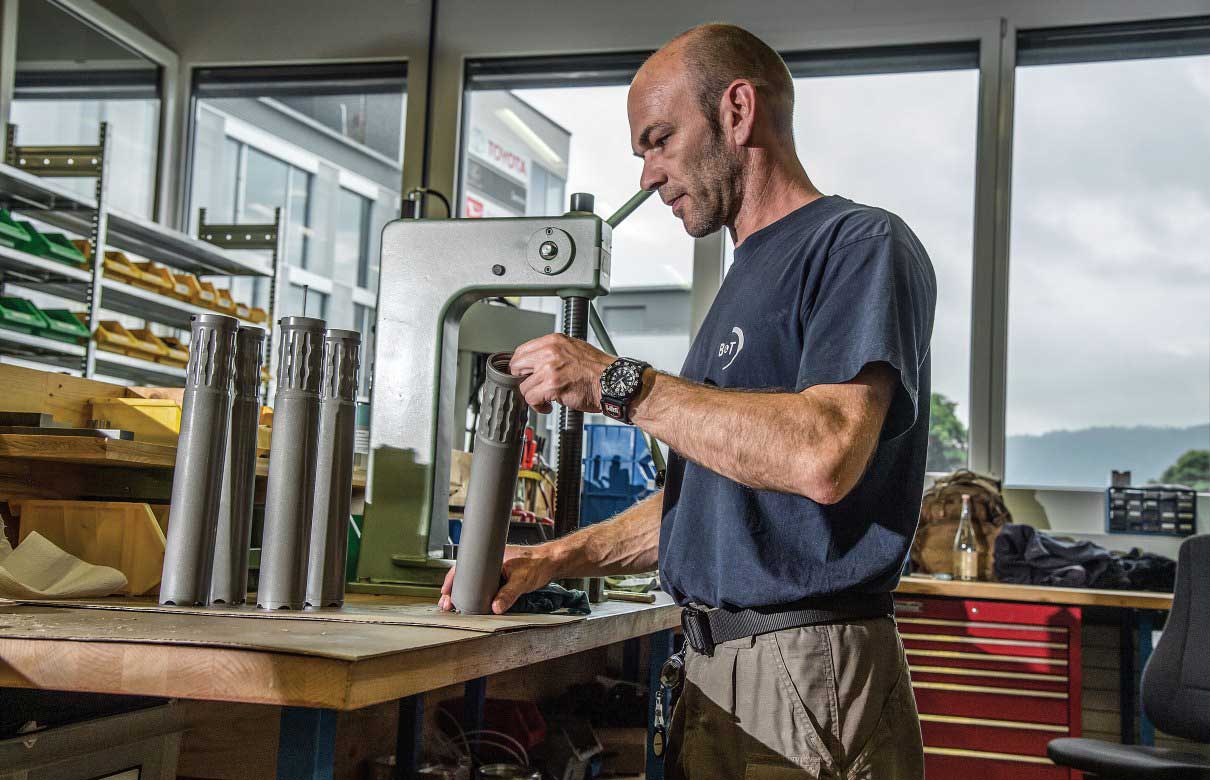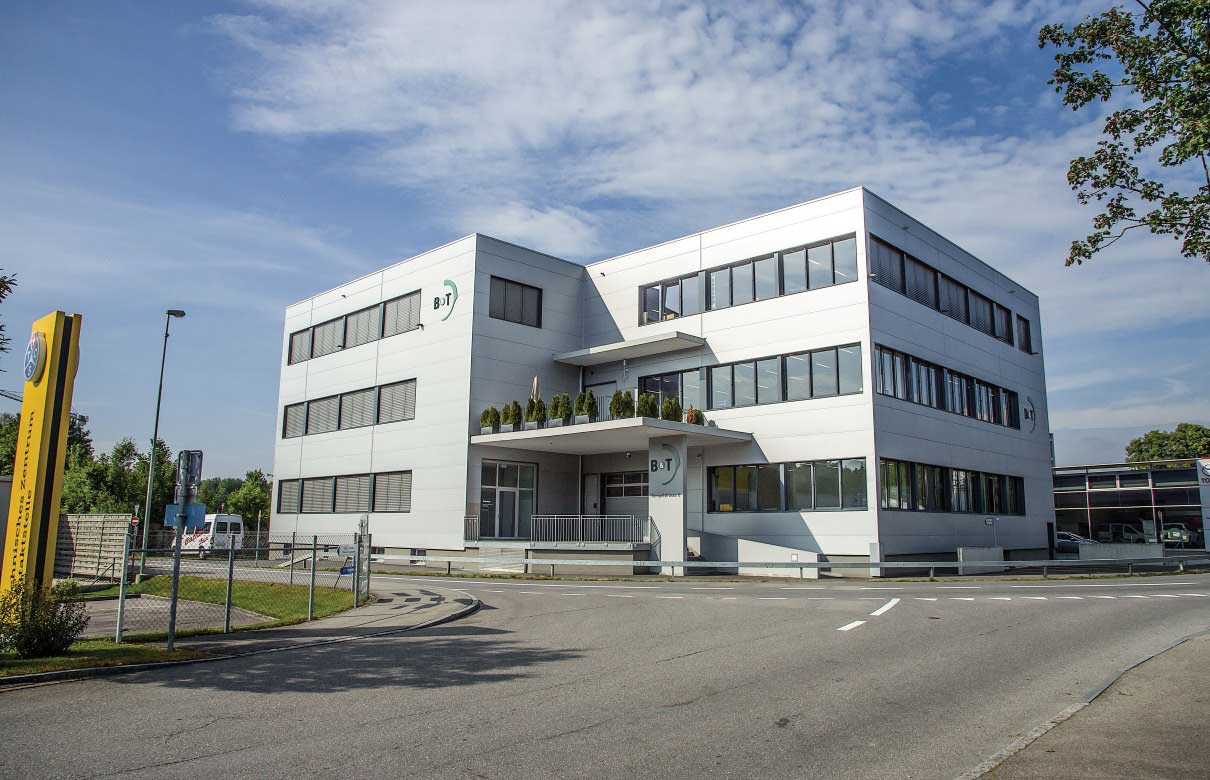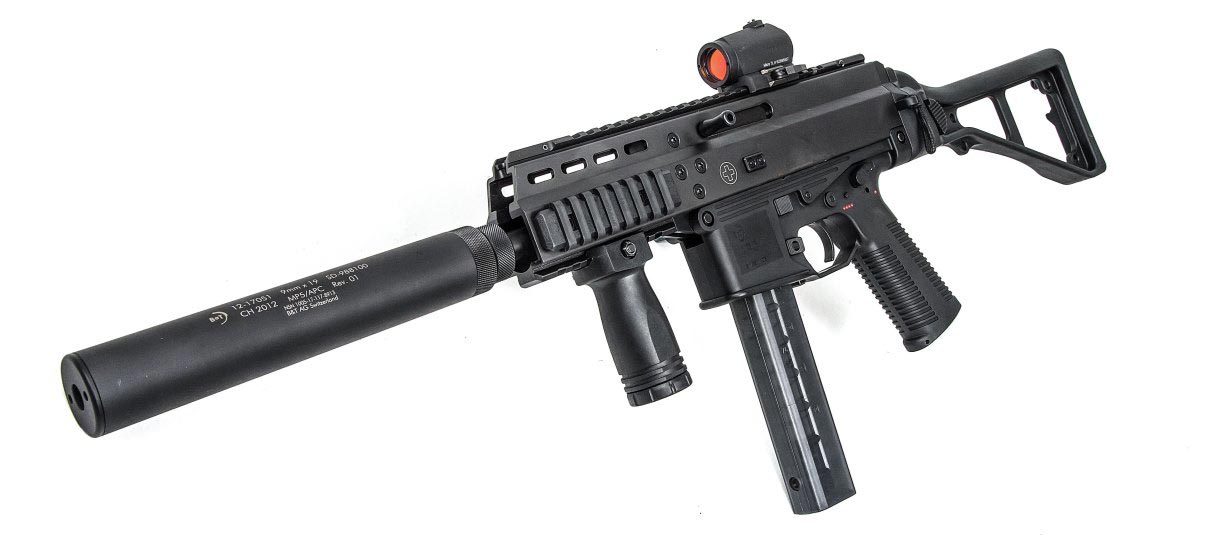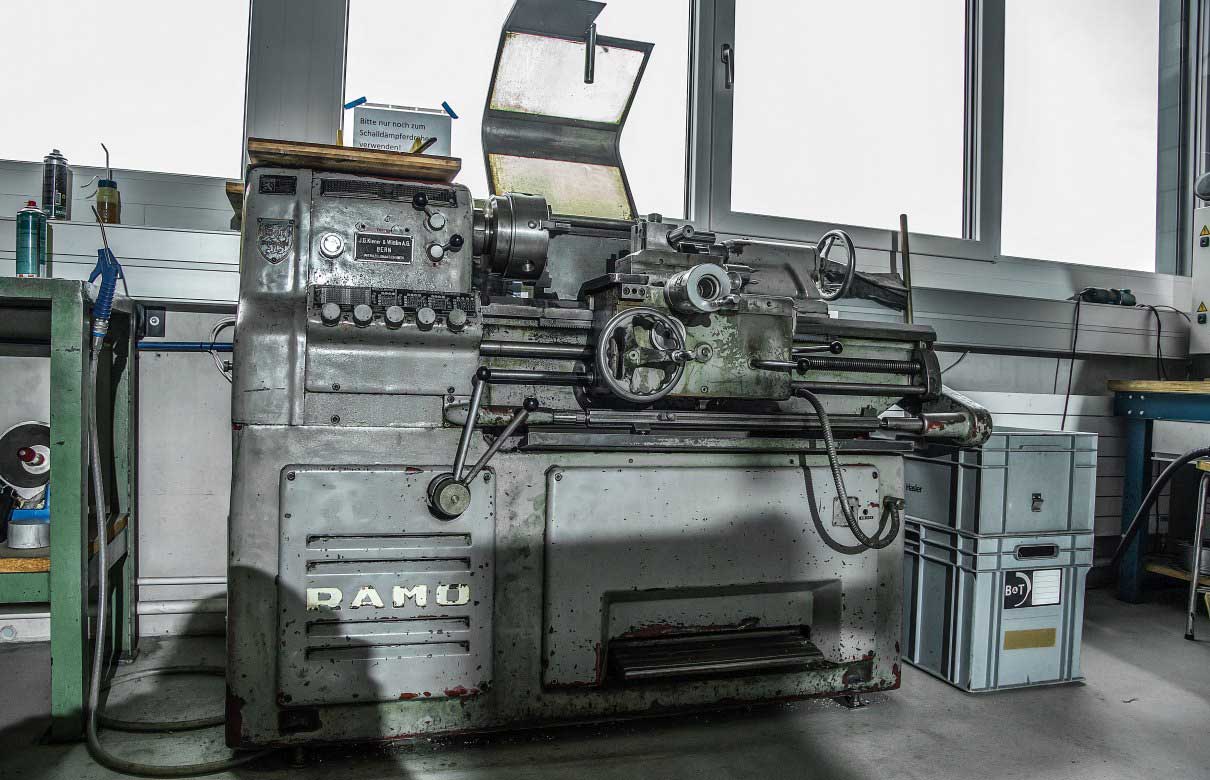Swiss Silence
By: Sean Utley
 (Photo courtesy of "Shooting Times")
(Photo courtesy of "Shooting Times")
Visiting Switzerland's Brügger and Thomet
Planes, trains and automobiles got us to the right spot. Scott Lambin and I arrived in Thun, Switzerland, for Brügger and Thomet’s Police Days. Think of it as a European, tactical-focused SHOT Show. Familiar names, such as 5.11, H&K and Swiss Arms were there as well as companies not so well known. This was an opportunity to see how tactical weapons and goods are showcased to LE, military and government agencies of European countries such as France, Spain and Belgium.
It’s a small event, so we had taken in all there was to see on day one. The following day we met Karl Brügger, owner of Brügger and Thomet (B&T). Leaving the event, we hopped over to the company’s facility where we witnessed how its suppressors are made.
B&T makes suppressors for several high-profile European arms manufacturers held in high esteem in the United States. They have done so for over 20 years. The quality of B&T’s products are of the highest in the world. While you might turn your face at that statement, consider this, B&T produced a limited run of 3,600 MP5s from 1996 to 2006 dubbed the B&T-96 semiauto carbine. This run of the heralded sub-gun is considered by some to be the best MP5 ever built. Yes, B&T is that good.
B&T was started in 1991 to make suppressors for the Swiss civilian market – as a hobby. B&T quickly became recognized nationally and internationally for its high-quality suppressors. The groundwork for this success was laid in 1984 when, at the age of 18, Karl Brügger made his first suppressor for a mini UZI simply because there was no suppressor available for it at the time. At the time, Brügger was a promising polymechanic (mechanical engineer) apprentice for Federal Powder Plant (Pulverfabrik Wimmis), which made all of the powder for the Swiss Army. With the development of his first suppressor, Brügger was destined for this role as arms manufacturer.
Shortly after B&T’s starting, Brügger began receiving guns from a buddy at H&K, and development began on suppressors for military small arms. Early developments weren’t so glamorous, though. Brügger admits there was no plan initially. No blue prints, just simple physics and engineering. Back then, baffles were straight, handmade 30mm tubes.

B&T makes suppressors for most of the European weapons manufacturers in their new facility in Thun, Switzerland. (Photo courtesy of “Shooting Times”)
Things are different now, but not as far removed from the past as you might think. The Star baffle, which is still used by B&T for certain applications, was first developed in 1971 for a 12.7mm sniper rifle. According to Brügger, for 9mm suppression, there is nothing better than the Star baffle. B&T’s latest Rotex V suppressors utilize stamped M baffles and CNC-machined K baffles. B&T has over 280 different suppressor designs in its ERP system and even more that were never printed.
Brügger gave us insight on everything from design advancements to comparisons to other companies. Nothing was off the table.
We asked Karl his thoughts on the most important factors in suppression. His response:
- Weapons life should be the same
- Flash reduction
- Noise reduction
- Weight
He commented that a suppressor should be tuned to the particular host weapon in order to keep bolt speed low. He also admitted the immense challenge that this is, likening suppressor design to a puzzle where each piece effects the other.
“The average shooter doesn’t need a tuned suppressor, but a professional does. Suppressor function with full-auto fire is more important than semiauto.”
Brügger on Design
In the days of outcomes that are predetermined by the latest in highly intelligent and technical software, you may be surprised by B&T’s refusal to rely on such things as flow dynamics software. They use no software in the development of their suppressors. They utilize forming and machining techniques to get to the end point. Brügger doesn’t feel that you can calculate how they will actually perform. Having the chance to compare his products to those designed with such software, he’s found very little difference in performance.
“Baffle spacing and diameter typically improve our results, along with different materials [that] we’ve played with.”
It’s an approach that intentionally keeps things simple. Karl commented that a suppressor should be able to take 400 rounds fired as rapidly as possible, be dismounted and used again.

B&T makes suppressors for most of the European weapons manufacturers in their new facility in Thun, Switzerland. (Photo courtesy of “Shooting Times”)
Why the Fuss?
You may be asking, “Why should we care about a suppressor manufacturer in Switzerland?” Simple. B&T’s line of suppressors and small arms are coming to the U.S. in the near future. Its APC-9mm pistol is already available through select dealers, and more products are to follow shortly. Swiss made products like these will satisfy the most persnickety gun-gear connoisseur.
Its Rotex line of suppressors are used extensively by NATO armies and partners. No doubt much of the popularity is due its ability to attach to any birdcage flash hider, via a unique Q.D. system. The Rotex V is the latest version of the hugely successful Rotex family, and is one of the lightest and smallest heavy-duty suppressors on the market at 19 ounces and 6.3 inches. It employs M-baffle technology and is made from Inconel and Thermax, which is a high-temp resistant steel. From subguns to .50 cal Barretts to the belt fed Minimi, B&T has designed suppressors for them all. We can’t wait for more of its cans to hit stateside and give them a complete shakedown.
Q&A: Karl Brügger Interview
So many questions, so little time. Yet Karl Brügger calmly addressed all of them with a modesty teetering on the nonchalant about B&T and its success.
Suppressor: Do you prefer the term silencer or suppressor?
Brügger: Suppressor is fine in English, Modérateur de son is used in French, but in German a common term is Schalldämpfer. That is why the MP5SD has the SD suffix. SD is a German abbreviation for Schalldämpfer.
Suppressor: What was the first suppressor you produced?
Brügger: My first Suppressor was made when I was 18 in 1984 for my mini UZI SMG, because there were no suppressors on the market. In those days, there was no special license needed to produce suppressors for personal or private use. I was in my second year of apprenticeship as a technical precision-mechanic, learning how to operate lathe and milling machines. Things have changed since then.
Suppressor: How has technology changed since your first suppressor?
Brügger: It has been baffle design, material used and attachments on the muzzle. In the beginning, we always used simple machined parts. Since we’ve had access to our own CNC machines, we went to more sophisticated designs for all the parts.

B&T technology still borrows help on occasion from old back-up lathes used to clean up the welds on their suppressors. (Photo courtesy of “Shooting Times”)
Suppressor: What companies have you designed suppressors for?
Brügger: At present, we are the OEM producer of suppressors for HK, Glock, FN Herstal, Beretta, SIG Sauer, Swiss Arms, Steyr, CZ, Tanfoglio and some other less-known European producers.
Suppressor: What were the challenges/difficulties in suppressor design?
Brügger: Just keeping high volume sales of suppressors at the same quality as single units. If a customer orders 1,000 suppressors, these should be the same quality as a single unit. All serious producers understand this challenge. This is also a Swiss thing.
Suppressor: What do you foresee in the future of suppressor technology?
Brügger: Weight reduction and muzzle flash reduction. For the last 12 years or so, many of our regular customers in NATO have been rotating in and out of conflict zones with a lot of good suggestions and serious requests. It seems that they are willing to sacrifice sound reduction for muzzle flash as long as we are below 140 dB. Think about it for a minute: It takes some very sophisticated measuring equipment to get a true reading on the sound a weapon will make. The human ear can’t tell the difference between a shot at 139 dB and 137 dB. The human eye, however, is immediately attracted to light. This is especially true at night. If the enemy can’t see the operator, then he will not be able to fire back.
Suppressor: Suppressors have become very popular in the U.S. recently. How does that compare to their popularity in Europe?
Brügger: Suppressor have always been popular in some countries and are sold as a registered accessory item. This just depends on the countries and the hunting culture. It seems the greater the hunting culture, the more reasonable the suppressors laws. It is changing all the time to the benefit of the industry, as there is recognition of the seriousness of hearing loss.
Suppressor: Who is your competition in suppressor development?
Brügger: There are good competitors in the UK and Finland who make a decent product for hunters in their countries.
Suppressor: Sound suppression is a good thing, but is there any reason that you can think of not to have a suppressor on a firearm?
Brügger: I can’t really think of a reason, but I would not put a suppressor on my 1902 Luger carbine and ruin the collector’s value.
Suppressor: Quick detach or direct thread? Which is best? Why?
Brügger: It depends on what the user wants to do with it. If one mounts a suppressor directly on the barrel, it save between 200 and 300 grams [7 to 10½ ounces] in weight. We recently supplied a nice quantity of our APC300 to a NATO Special Forces unit. They wanted the APC300 to have the suppressor mounted on the barrel as they explained they will never shoot the weapon without using the can. This was a real working team that is often in action in Africa, and the weight saved is equal to extra water or an extra magazine of ammunition.
Suppressor: What are the negatives of suppressors?
Brügger: Suppressors will make a weapon dirtier faster, change the POI and POA, wear out the internal parts more quickly if it is an automatic weapon and extend the length of the weapon. We, and many of our customers, seem to accept these issues as a good trade-off for all the benefits a suppressor provides.
Suppressor: Does the average suppressor owner need a full-auto rated suppressor?
Brügger: No, not really. This is a point of discussion sometimes among our staff. Some other companies in the trade claim that their cans are lighter, which they are, but the wall of the tubes are much thinner and can’t absorb and dissipate the heat when fired on full automatic. Frankly, the vast majority of our suppressors are sold to professional users who do indeed use full-automatic fire. That is why our product are tested, qualified and selected by the OEMs here in Europe. For a typical civilian shooter, they do not need a suppressor that is rated for full-automatic fire. This is like owning a Ferrari in a country where the driver can’t drive over a 100 kilometers per hour.
When pressed about his success in dominating OEM suppressor manufacturing, Karl credits a good close team of motivated employees. And he meant that, deflecting any credit away from himself.
“We get no returns on suppressors or parts, all the way down to our Q.D. levers. The only misalignment issues are a result of shooter error.”